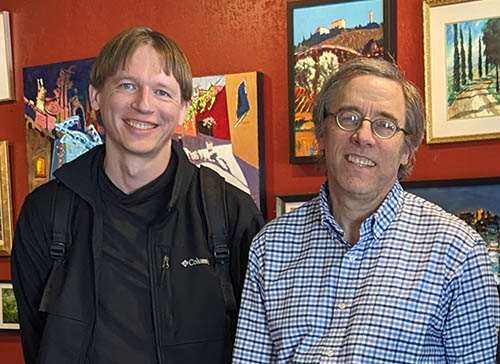It was while his father was recovering from surgery that a young Daniel Spiewak (’12 BS computer science) and his dad began learning computer programming together. They started with trial and error, with the younger Spiewak typing in the commands. His dad eventually lost interest, but his son was hooked.
“I saw that I could, very literally, tell the computer to do something one step at a time. And when I do that, there’s an outcome that’s more than a sum of its parts,” Spiewak said. “It could calculate something I didn’t actually tell it to do. I just had to learn more.”
He was already working remotely as a programmer while in high school and during his undergraduate years, while he lived at home in rural Wisconsin. Commuting to UWM meant he typically spent three hours on the road on school days.
But the effort to earn his degree was worth it, Spiewak said.
In 2023, he was named Distinguished Engineer at NVIDIA, which recently became the world’s most valuable company. While known for its semiconductors that enable gaming and artificial intelligence, the company also creates other computing hardware and software solutions, such as those needed to make cars autonomous, or “self-driving.” The related data problems are his daily focus.
The AI behind self-driving vehicles
Spiewak visited campus in April to give two computer science lectures, one tailored for a technical audience and another designed for a general audience that focused on the data that fuels artificial intelligence.
How are autonomous vehicles and gaming graphics related? The computation behind autonomous vehicles must recognize a very dynamic world and respond to it in a similar way to how a video game unfolds, Spiewak said. But the answer really lies in the mathematics, he added.
“In a video game world, if you throw a ball and expect it to bounce, you have to calculate the physics. That’s a four-dimensional problem.”
Turns out, the math used to create this software is the very same math needed to evaluate a neural network, he said. And neural networks are the backbone of deep-learning algorithms used in recognizing and predicting behaviors in reams of data.
While Spiewak believes the technology for driverless cars is not ready for consumer use yet, he does think it will be. “Human intuition is your brain recognizing patterns based on past experience,” he said. “We’re getting to a point where we can teach models to do this.” Already, he points out, consumers are seeing the software deployed piecemeal. For example, some vehicles correct themselves without driver intervention if they cross into another lane.
UWM over UW-Madison
When it was time for college, Spiewak lived equidistant from UW-Milwaukee and UW-Madison. “It did come down to choosing between the two,” he said. “But I decided on Milwaukee because I thought the approach was a lot more grounded in engineering fundamentals there. And what some of the faculty were doing looked more interesting to me than at Madison.”
His evaluation of his first year was lukewarm, he remembers. That changed his sophomore year when he took a course with Professor John Boyland.
“He’s a very thoughtful guy and you can talk to him at an extreme depth,” Spiewak said.
“It was with Dr. Boyland whom I went to my first conference with and I have been a regular speaker at conferences now for the past decade and a half. All of that started right here.”
Two other classes he took with Professor Christine Cheng had a profound impact on him too, he said.
“I use what I learned in those two courses every day and that’s not an exaggeration. I’ve spent a lot of my career building compilers and algorithms and analyzing them with these formal methods.”
